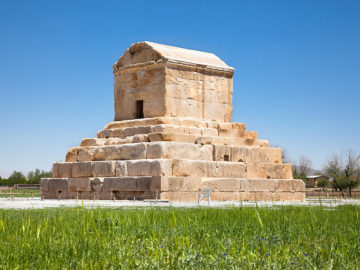
Pasargadae was the earliest capital of the Achaemenid Empire under Cyrus the Great (600 – 530 BCE) who had ordered its construction. Pasargadae was the capital of the Achaemenid dynasty until Cambyses II (559 – 522 BCE) moved it to Susa. The site covers 1.6 square kilometers and includes the Mausoleum of Cyrus II, two royal palaces with gardens, and forts of Tall-e Takht.
The most prominent monument in Pasargadae complex is the tomb of Cyrus. The tomb’s height reaches almost eleven meters consisting of two main parts; a high plinth composed of six receding steps similar to Mesopotamian or Elamite ziggurats, and a tomb chamber with a steep-pitched gable roof resembling Urartu tombs of an earlier period. The main decoration on the tomb is a rosette design over the main entrance door.
Two royal palaces of Cyrus; residential Palace P and audience Palace S put revolutionary impacts on the architectural history of the ancient Near East. While a single-focal axis was dominated in the region for millennia, a symmetric four-sided structure with no principal axis and no fixed focal point was introduced in Pasargadae’s palaces. This structure is considered as the prototype of Persian Gardens. The superb technical application of elements of Lydo-Ionian stone-working including anathyrosis joints was also another architectural revolution in the area. Before then, columned halls were built with mud-brick walls and wood columns.
Audience Palace S consists of a central rectangular columned hall with two rows of four columns, each wall opening to a portico. The plan of Palace P resembles Palace S, the latter has more but smaller columns supported by exceptionally finely-made, horizontally- fluted tori on black and white plinths.
Discovered Inscriptions in Pasargadae are written in Old Persian, Elamite, and Akkadian cuneiform. Cyrus had introduced himself in one of the inscriptions, but since the Old Persian cuneiform was invented in the reign of Darius, researchers suggest that Darius completed several elements of Cyrus’ unfinished constructions purportedly to tie himself to the heritage of Cyrus. Located at the eastern edge of the Palace, Gate R is visible with a three-meter carved human figure with wings inspired by Assyrian sculpture.
The fortified and solid stone-made platform of Tall-e Takht (or Takht-e Madar-e Soleyman, the Throne of the Mother of Solomon) was built on a massive hill. A fourteen-meter high tower built almost exclusively of finely cut blocks of white limestone known as Zendan-e Soleyman (Solomon’s Prison) was also located in the north of the palaces. Sacred area, Tangeh Bolaghi, and Mozaffari caravanserai (Islamic era) are among other key constituents of the Pasargadae.
This work was globally registered in 2004.


